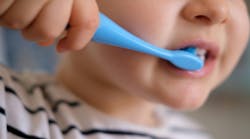An unprecedented advancement in dental technology has emerged through a new protein-based gel that can repair eroded or demineralized tooth enamel. The new gel could be available commercially as early as next year.
Scientists at the University of Nottingham's School of Pharmacy and Department of Chemical and Environmental Engineering created the compound that’s designed to restore eroded or demineralized enamel. Their innovative process mimics the natural growth processes of tooth enamel and is made from proteins that imitate those responsible for natural enamel formation early in life. Their findings were published in Nature Communications on November 4.
Why this matters: Current enamel loss treatments only offer temporary protection
Because enamel cannot regenerate, dentistry has long focused on prevention and temporary protection. Current fluoride varnishes and remineralization products offer temporary relief but have never been able to rebuild lost enamel.
In their tests, the scientists applied the fluoride-free gel in a thin layer over teeth to form a protective coat that repairs and regenerates damaged tooth enamel. This is something that, until now, has been impossible. Scientists say the gel can help prevent cavities, repair exposed dentine, reduce sensitivity, and improve how restorations bond to the tooth surface.
Applied like fluoride treatments, the gel forms a coating by seeping into teeth’s tiny cracks and holes and filling them in. It then captures phosphate ions and calcium from saliva, which form into new enamel through a process called epitaxial mineralization.
How the gel works: Mimicking natural enamel formation to rebuild tooth structure
"Dental enamel has a unique structure, which gives it its remarkable properties that protect teeth throughout life against physical, chemical, and thermal insults,” Dr. Abshar Hasan, a lead author of the study, explained to Science Daily. “When our material is applied to demineralized or eroded enamel, or exposed dentine, the material promotes the growth of crystals in an integrated and organized manner, recovering the architecture of our natural healthy enamel. We have tested the mechanical properties of these regenerated tissues under conditions simulating 'real-life situations' such as tooth brushing, chewing, and exposure to acidic foods, and found that the regenerated enamel behaves just like healthy enamel."
“We are very excited because the technology has been designed with the clinician and patient in mind. It is safe, can be easily and rapidly applied, and it is scalable,” explained Professor Alvaro Mata, lead investigator on the project, to Science Daily. “Also, the technology is versatile, which opens the opportunity to be translated into multiple types of products to help patients of all ages suffering from a variety of dental problems associated with loss of enamel and exposed dentine. We have started this process with our start-up company Mintech-Bio, and we hope to have a first product out by next year."
Their ultimate goal? To help patients increase the longevity of their own healthy teeth and redefine modern dentistry while they’re at it. We now know—think oral-systemic link—that a healthy mouth ultimately leads to fewer health problems in the population overall. There’s not a much better outcome than that.
Read the study in Nature Communications.



